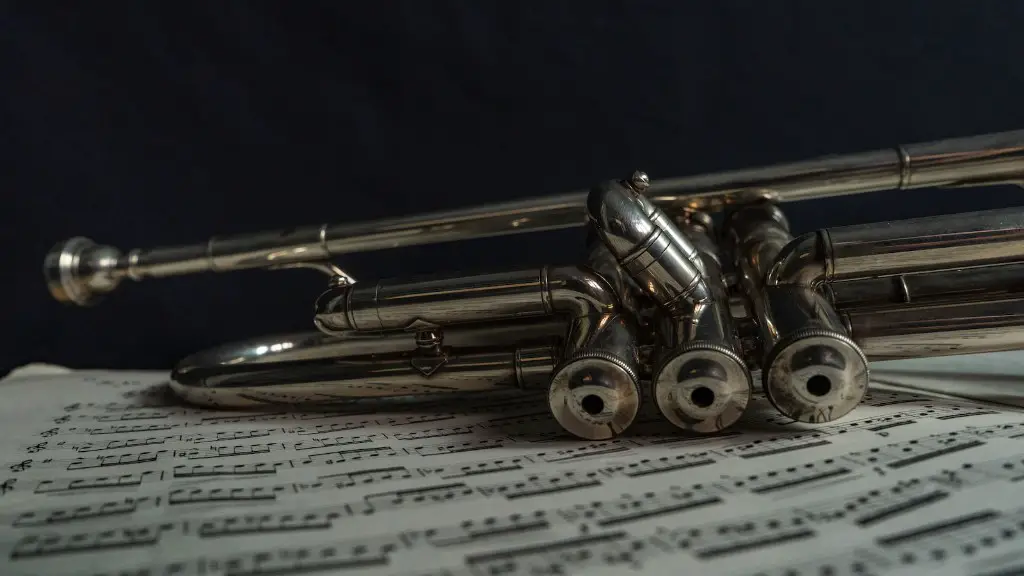Playing the trumpet is a fun and rewarding experience, but getting a great tone can be difficult. Achieving a good trumpet tone requires practice, patience, and proper technique. Knowing how to use your embouchure, tongue placement, air support, and instrument setup can all help you get the most out of your playing. In this article, we’ll discuss the basics of getting a great trumpet tone.
The first step in achieving a great sounding trumpet is setting up properly. This means making sure your mouthpiece is properly positioned and that it fits correctly in your lips. You should also make sure that your instrument is in tune with itself by using an electronic tuner or tuning slide.
Once you have your instrument setup properly, it’s time to focus on proper embouchure. Your embouchure should be firm but relaxed – think of it as giving a firm handshake. Your lips should be curved inward slightly while still allowing room for air to flow through the mouthpiece.
Your tongue placement also plays an important role in achieving the right sound on trumpet. To get the best sound possible, you should position your tongue at the roof of your mouth slightly behind your upper teeth. This will help create an even airflow and provide better control over dynamics and articulation.
Finally, air support is essential for good trumpet tone. Make sure you’re breathing deeply and evenlyClean the trumpet regularly to ensure good tone. Wipe down the outside of the instrument with a dry cloth after every use and use a brass polish to remove dirt and grime from the valves and slides. Ensure that all moving parts are oiled regularly, as well as cleaning the mouthpiece with a mild detergent and warm water. Check for any damage or corrosion to the trumpet, and repair or replace any parts that are necessary.
Warm-up Before Playing
Playing the trumpet requires you to have good tone and control. To warm-up your trumpet playing, start with some very simple exercises. First, buzz your lips with a mouthpiece, then move on to playing long tones in each register. As you move up and down the register, remember to use your air support to help you stay in tune and achieve a good sound. Next, practice your articulation and dynamics by playing some scales or arpeggios. Make sure to start out slow and gradually build up your speed as you work on accuracy. Lastly, try playing various jazz etudes or classical studies to incorporate different styles of music into your warm-up routine. This will help you develop a strong sense of control over your instrument and allow you to achieve a rich, vibrant tone.
Adjusting Embouchure
Creating a good tone on the trumpet is all about adjusting your embouchure. This involves finding a comfortable position for your lips, teeth and jaw that produces a clear sound. It also means finding the right balance of air and lip pressure to help you control the pitch, volume and quality of sound.
The best way to find the right embouchure is to experiment with different positions until you find the one that works for you. You may need to adjust your jaw or lips slightly in order to achieve the desired sound. Make sure not to over-tighten your lips as this can cause fatigue and strain on your muscles.
Practice using long tones so that you can get used to different positions and learn how they affect your sound. Try using different volumes of air, as well as experimenting with articulations such as slurs, staccatos and legatos. It’s important to remember that it takes time and patience to develop a good embouchure. With practice, you’ll be able to find an embouchure that works for you and helps you produce a beautiful tone on the trumpet.
Using the Right Mouthpiece to Get Good Tone on Trumpet
Finding the right mouthpiece for your trumpet is one of the most important steps you can take to get a good tone. The right mouthpiece can make all the difference in how your trumpet sounds and feels when you play. The type of mouthpiece you use will depend on your playing style, embouchure, and sound preference. A good starting point is to use a medium-sized cup with a standard rim size. This type of mouthpiece will provide a good balance between volume, tone, and range. It is also important to choose a mouthpiece that fits comfortably in your lips without causing any tension or discomfort.
Choosing a good quality mouthpiece is also important for achieving the best sound possible. Look for a mouthpiece made from high-quality materials such as brass or stainless steel that have been machined precisely for optimal performance. Also make sure to check if it has been tested and approved by professional musicians before buying it. It’s also important to try out different models before making a purchase, as each player has their own preferences when it comes to sound quality and comfort.
Finally, make sure to maintain your trumpet’s mouthpiece regularly by cleaning it after each use and replacing any worn or damaged parts as needed. This will help ensure that you get optimum performance from your instrument while also preserving its longevity. By taking these steps, you’ll be able to achieve great tone on your trumpet with ease!
Air Pressure and Flow
Getting good tone on a trumpet takes practice, but there are a few key points to keep in mind that can help make the process easier. The two most important factors in producing a good trumpet tone are air pressure and flow. Air pressure is the amount of force that is used to create sound. If the air pressure is too low, the sound will be weak and lack clarity; if it is too high, the sound will become distorted and harsh. The air flow should be consistent and steady; if it is too fast or slow, tone quality will suffer. Practicing with a metronome can help you find the right balance of air pressure and flow.
Another important factor in producing good trumpet tones is embouchure, which is the way your lips are shaped around the mouthpiece. A strong embouchure will produce a full and focused sound, while a weak embouchure can result in thin or muddy tones. Embouchure should also be consistent from note to note; any variation will cause changes in tone quality.
Finally, proper breath support is essential for creating powerful trumpet tones. Taking deep breaths before playing helps to fill your lungs with oxygen, which gives you more power and better control over your sound. Playing with proper posture also helps with breath support—keeping your back straight helps open up your lungs and allows air to flow freely through them.
By focusing on air pressure and flow, embouchure, and breath support when practicing the trumpet, you’ll gradually develop good tone quality over time. With enough practice, you’ll be able to produce beautiful sounds on your instrument!
Proper Placement of Lips
Good tone on the trumpet starts with proper lip placement. The trumpeter should place the mouthpiece at the center of the lips, with equal pressure from top and bottom. To ensure a secure fit, the musician should take a deep breath and puff out their cheeks to create a tight seal. This will also help to increase air pressure in the mouthpiece. Additionally, it’s important to avoid tensing up the lips when playing, as this can lead to poor sound quality and intonation issues. It’s also important to ensure that the tongue is positioned correctly when playing; a good starting point is putting the tip of your tongue behind your top teeth.
The angle of lip placement is also essential for proper sound quality on the trumpet. The most common angle for beginners is 45 degrees, though this may vary slightly depending on individual anatomy and playing style. When done correctly, proper lip placement will lead to better tone production and improved endurance while playing. Additionally, correct lip placement can help prevent any potential mouthpiece tooling or damage that could occur due to incorrect use.
Overall, having correct lip placement is essential for getting good tone on trumpet. With practice and dedication, any musician can learn how to properly place their lips in order to achieve optimal sound quality.
Intonation and Pitch
Having good tone on trumpet can be a challenge, but with practice, it’s attainable. To create a great sound, the player needs to focus on intonation and pitch. Intonation is the ability to play in tune with other instruments or voices in an ensemble setting. Pitch is the sound quality of the note, which can be changed depending on how the player uses their embouchure and air. To get a good tone on trumpet, start by playing long tones using a metronome to make sure you are playing in tune with the click. Work on your embouchure and air support by gradually increasing your range as you become more comfortable with playing longer notes and sustaining them without changing pitch.
Additionally, practice playing intervals such as major or minor thirds. These intervals are particularly important for keeping intonation consistent between notes. Once you are comfortable with intervals, move on to scales and arpeggios. Scales help develop your range while arpeggios help develop your control of dynamics and articulation. Lastly, work on different articulations like slurs, staccatos, legatos, etc., as they help improve your overall sound quality by adding texture to your playing. With dedication and practice, any trumpet player can achieve great intonation and pitch!
To Sum it All Up
Good tone on a trumpet requires a great deal of practice. It is important to warm up correctly, use proper posture and embouchure, and focus on intonation and pitch. You should also be aware of how tonguing and articulation can affect your tone. By following these steps, you will be able to produce a good tone on your trumpet. Practice makes perfect, so don’t give up even when it gets challenging!
As with any musical instrument, good tone on the trumpet takes time and effort. With dedication and practice, you will be able to master the techniques needed to produce a great sound on your trumpet. So get out there and start playing!





